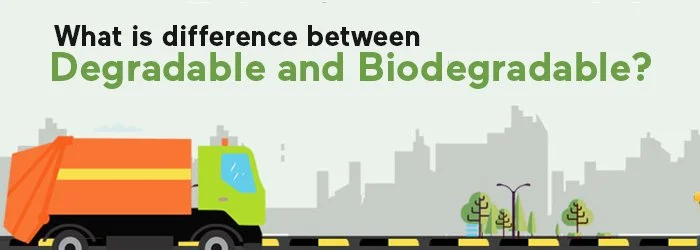
In our daily life, we encounter different kinds of packaging. This packaging may contain our groceries, food items, or any daily-use products. We usually find written degradable or biodegradable on them. What is all this fuss about? Degradation refers to the breakdown of molecules into simpler forms. This may involve breakdown through ultraviolet rays, some chemical reaction, or any natural aspect taking place all the time around us. Degradation takes place in different ways, which depend on the chemical composition of the substance. Here we will discuss the two most popular types of decomposition:
Degradable materials are those that cannot be broken down into a simple form with the help of natural factors such as UV rays, heat, and soil. The composition of these kinds of materials involves aluminum, plastic, and other complex chemical substances. Degradable materials, when open to the natural environment, are very resistant and take a lot of time to decompose.
Degradable plastic or polythene bags can be taken as an example of degradable items. You can just decompose them by cutting, grinding, and crushing, which also consumes a lot of energy, thus making it an expensive way of recycling. To handle this environmental issue, a lot of research is being conducted.
Now, to decompose degradable plastic quicker, chemical additives are used, which allow the plastic to break down fast as compared to standard plastic.
Now come the biodegradable materials, as the name indicates that they are degradable, as well as the natural aspects that are also involved in the breakdown process. In biodegradation, microbes or microorganisms such as bacteria play a vital role in breaking up the material into a simple form. Other natural aspects, such as heat, UV rays, water, oxygen, and acid rain, play the role of catalysts, which facilitate the process of degradation. Paper bags and cardboard boxes are biodegradable, as their composition involves pulp from trees.
After biodegradation, the substances become part of the soil, so this is the most eco-friendly way of degradation. Biodegrading is being encouraged all over the world now; the plastic bags are made from biodegradable substances such as corn and wheat starch instead of petroleum substances. These bags, when left in a temperature of 50 degrees Celsius, degrade fast with the help of other natural catalysts.
Degradable and biodegradable are the most discussed ways of degradation, but they are totally different from each other. Here are some points on the basis of which they are in contrast to each other.
The first and foremost thing is decomposition. Biodegradable items can be decomposed easily with the help of the natural environment. Microorganisms such as bacteria and fungi break them down into simpler forms, eventually making them part of the environment again. For example, if you throw a banana peel, a lot of microbes will act on it and decompose it with the help of other natural resources such as light and heat, hence making it part of the soil again. On the other hand, degradable substances are those that are very resistant to the natural environment and do not decompose easily because of their nature of composition, such as plastic polythene bags. They even take thousands of years to decompose.
Biodegradable materials decompose naturally, which makes them highly eco-friendly. They are broken down by the microbes, hence becoming part of the natural environment again. This also increases the fertility of soil and also makes fossil fuels. As compared to this, degradable materials are a threat to the environment, as they do not decompose easily. For example, if you bury a plastic bag in soil, it will remain as such even after many years.
Biodegradable and degradable materials also differ in composition. Biodegradable substances are mostly made up of natural resources such as trees. Paperboard or cardboard is made from the pulp of the palm tree and thus decomposes very easily; on the other hand, degradable materials are made from petroleum, polythene, and other complex chemical substances, which make them harder to decompose.
Biodegradable substances may comprise waste that is caused by different foods, such as fruits and vegetables. They also include paper material such as thin papers and cardboard. In contrast to this, degradable substances involve plastic, polythene, materials made from petroleum, aluminum, and other toxic chemicals, which make them hard to decompose.
Biodegradable bags do not break down into biomass, carbon dioxide, and water. A degradable bag is still a petroleum-based plastic bag that fragments down into smaller pieces.